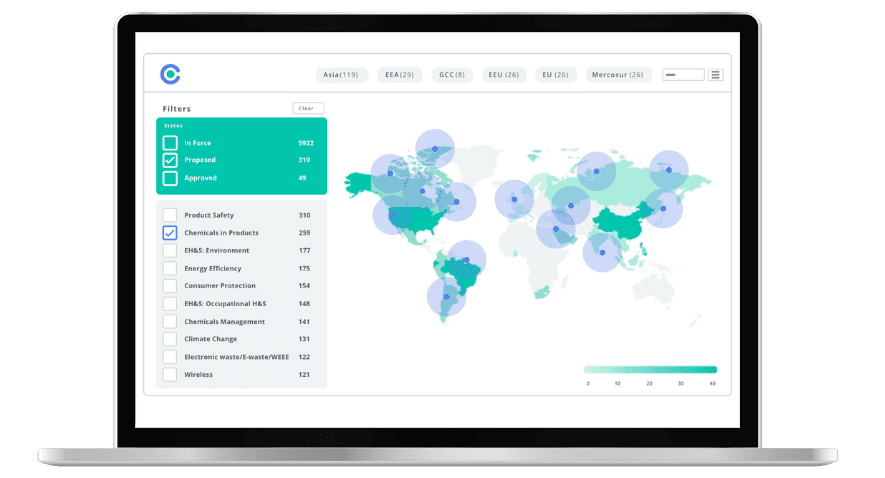
EPR for Textiles: Washington and New York Make the First Move

This blog was originally posted on 5th February, 2025. Further regulatory developments may have occurred after publication. To keep up-to-date with the latest compliance news, sign up to our newsletter.
AUTHORED BY EMILIA ASSENZA, SENIOR TEAM LEADER AND REGULATORY COMPLIANCE SPECIALIST, COMPLIANCE & RISKS
This year, Washington and New York are the first US States to have introduced a bill aimed at establishing Extended Producer Responsibility (EPR) for Textiles. Both bills propose the creation of an EPR program and the submission of plans for the management of covered products.
Producers will be responsible for the collection, reuse, recycling, and safe disposal of covered products.
The definition of “covered product” is similar in both bills and includes an apparel or textile article. The New York’s bill further specifies that the covered product “is unsuitable for reuse by a consumer in its current state or condition”.
“Apparel” means clothing and accessory items intended for regular wear or formal occasions (a non-exhaustive list is included in both bills), with the exclusion of Personal Protective Equipment (PPE), military equipment and personal hygiene products.
“Textile article” means an item customarily used in households or businesses that are made entirely or primarily from a natural, artificial, or synthetic fiber, yarn, or fabric (a non-exhaustive list, with few differences, is included in both bills).
Key provisions of each Bill are highlighted below.
New York – Senate Bill 3217
This Bill, proposed on 24 January 2025, by the New York State Senate would add a new Title 34 under Article 27 of Environmental Conservation Law, dedicated to extended producer responsibility for textiles.
Producer Plan
No later than 31 December 2026, producers, either individually or cooperatively, must submit a plan for the establishment of a collection program to the Department of Environmental Conservation.
A producer may satisfy the textile collection program requirement by agreeing to participate collectively with a group of other producers or with a representative organization. Any such producer participating collectively in a collection program shall notify the department of such participation.
The plan, submitted by the producer or representative organization to the department, shall include the following information:
- A list of participating producers
- Information on products covered by the program
- Information on the collection, transportation, recycling, and processing methods
- Information on how the program will provide a convenience standard for free collection. To meet such convenience standard, the plan may include voluntary agreements to establish collection sites at public and private facilities, recycling facilities, or retailers
- Information on how discarded covered products will be transported, tracked and handled together with methods for reusing or recycling
- Education and outreach efforts to inform consumers and others about the program. This shall include, at a minimum, a website, a toll-free telephone number and written information at the time of sale of covered products
- Information on how the program will meet annual performance goals
- Any incentives for retailer participation
- An estimate of the amounts of covered products that were previously sold, offered for sale, or distributed in the state under each producer’s name or brand that are discarded annually
The plan needs to be updated every three years or when there is a revision of the collection program’s goals.
Producer Responsibilities
No later than 1 July 2027, the producer or representative organization must implement a free, convenient, and adequate collection program for covered products utilizing collection sites. After this date, it is prohibited to sell covered products unless the producer is implementing or participating under an approved plan. Producers are responsible for the costs associated with the implementation of the collection program.
Producers must maintain records demonstrating compliance for three years.
Within 18 months following approval of the producer plan, and annually thereafter, the producer or representative organization must submit a report to the department detailing, for the previous program year, the program and other relevant information regarding collection methods and sites, estimated weight of discarded products, evaluation of whether the performance goals and recycling rates have been achieved, total cost of implementing the program, and educational materials provided to consumers.
Retailer, Distributor and Wholesaler Responsibilities
Beginning 1 July 2027 retailers, distributors, and wholesalers cannot sell or offer covered products unless the producer is participating in a collection program. Retailers can ensure compliance by checking if the producer or the covered product’s brand is listed on the Department’s website as participating in an approved program. Retailers, distributors, and wholesalers can voluntarily participate in the collection program as designated collection sites, in accordance with applicable laws and regulations.
Labeling Requirements
One year after a producer’s plan is approved by the Department of Environmental Conservation, covered products sold or offered for sale in New York must display the producer’s name and contact information.
Role of the Department
The Department of Environmental Conservation is responsible for maintaining a list of producers of covered products who have submitted plans for approval and those implementing or participating in approved plans. The department’s website must display such list together with the location of all collection sites.
The Bill also sets out the procedure for the approval of the proposed plans by the department.
A Textile Stewardship Advisory Board within the department is established to provide recommendations to the commissioner regarding program operator plans.
The department is also authorized to promulgate any rules and regulations necessary to implement this Title.
Penalties
Any producer, representative organization or retailer who is found to not have made a good faith effort to comply with any provision of or fails to perform any duty imposed by this Title shall be liable for a civil penalty not to exceed five hundred dollars for each violation and an additional penalty of not more than five hundred dollars for each day during which such violation continues.
Proposed Date of Entry into Force
If enacted, the Bill is proposed to take effect immediately.
Washington – House Bill 1420
Introduced on 20 January 2025, it establishes a statewide extended producer responsibility program for apparel and textile articles.
Producers and Producer Responsibility Organizations Obligations
By January 2027, producers must register with the department as a producer responsibility organization, or join a producer responsibility organization.
Each producer responsibility organization whose registration has been approved by the department must, individually or collaboratively, prepare and cover the costs of the needs assessments described in Section 5 of the Bill. An initial needs assessment for covered products must be completed prior to the completion and approval of a plan for covered products. The initial needs assessment must be submitted to the department by 1 March 2028.
Needs assessments must be updated, in whole or in part, at least every five years.
Plans to be Established by the Producer Responsibility Organization
Sections 6 and 7 regulate the requirements for plans that must be submitted by the producer responsibility organization or the individually registered producer to the department.
The plan must include:
- Information on the producers
- A description of the funding mechanism
- Performance standards and metrics for producers (quantifiable five-year and annual performance targets)
- A description of how covered products will be sorted, transported, processed and recycled
- A description of the education and outreach program
- Coordination with other producer responsibility organizations
- A description of how the plan will address the presence of harmful chemicals, specifically perfluoroalkyl and polyfluoroalkyl chemicals
The complete plan must be submitted to the department by 1 January 2029 and its implementation shall begin by 1 April 2031.
Based on Section 8, producers are obliged to achieve the quantifiable five-year and annual performance targets as set out in the plan. After 1 March 2033, the department may furthermore establish streamlined performance standards based on information gathered through the plans, annual reports and other sources of information.
Producer responsibility organizations are also obliged to designated collection sites under their program and provide for a free and convenient drop-off or collection system for covered products that may include temporary collection sites and mail-back options.
Obligations for Retailers, Importers, Distributors, and Online Marketplaces
Retailers, importers, distributors, and online marketplaces are obliged to monitor the department website to determine if producers are compliant with the EPR requirements. They are prohibited from introducing covered products for use in the state unless the producer is listed as compliant. Online marketplaces must furthermore provide information to the department on an annual basis about all third-party sellers with sales of covered products over $1,000,000 sold on their online marketplace in the previous year.
Penalties
The department may pose a civil penalty of up to $1,000 per violation per day on any producer who violates this chapter and up to $10,000 per violation per day for repeating violations. Fines of up to $10000 and $50000 respectively are applicable to producer responsibility organization.
The department may also issue corrective actions, orders to ensure continued implementation, revoke approval of the plan or require its revision within a specified timeframe.
Implementing Rules
By 31 December 2027, the department shall adopt the necessary rules for implementation and enforcement.
By 1 October 2026, the department must notify each registered producer responsibility organization of its estimated regulatory costs to implement the program.
Within 12 months of the effective date of this rule, and by 1 July each year thereafter, the department must furthermore publish a list of producers that are in compliance with the EPR rules on its website.
Stay Ahead Of Regulatory Changes in Extended Producer Responsibility for Textiles
Want to stay ahead of regulatory developments in Extended Producer Responsibility for textiles?
Accelerate your ability to achieve, maintain & expand market access for all products in global markets with C2P – your key to unlocking market access, trusted by more than 300 of the world’s leading brands.
C2P is an enterprise SaaS platform providing everything you need in one place to achieve your business objectives by proving compliance in over 195 countries.
C2P is purpose-built to be tailored to your specific needs with comprehensive capabilities that enable enterprise-wide management of regulations, standards, requirements and evidence.
Add-on packages help accelerate market access through use-case-specific solutions, global regulatory content, a global team of subject matter experts and professional services.
- Accelerate time-to-market for products
- Reduce non-compliance risks that impact your ability to meet business goals and cause reputational damage
- Enable business continuity by digitizing your compliance process and building corporate memory
- Improve efficiency and enable your team to focus on business critical initiatives rather than manual tasks
- Save time with access to Compliance & Risks’ extensive Knowledge Partner network

Updates on Key EU Environmental Regulations and China RoHS
Uncover recent key updates and issues that could have significant effects on manufacturers, their approaches to product development, and their supply chains.


